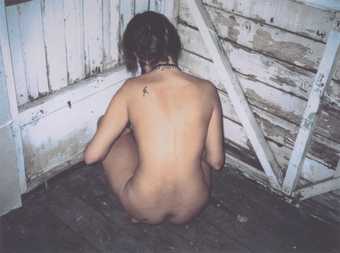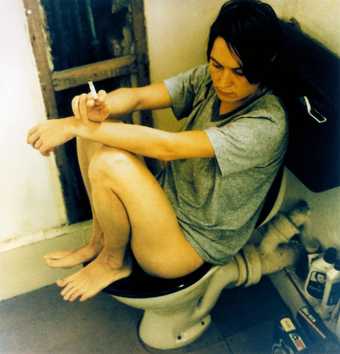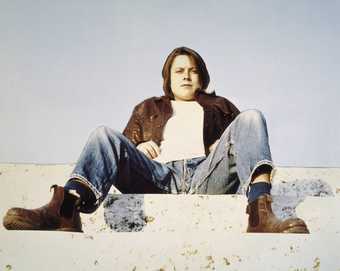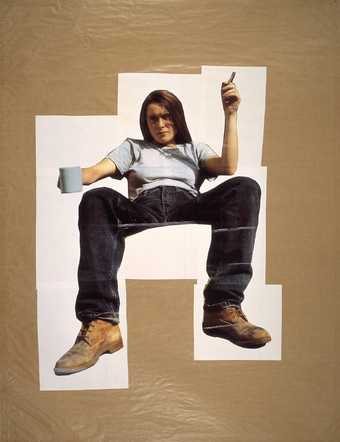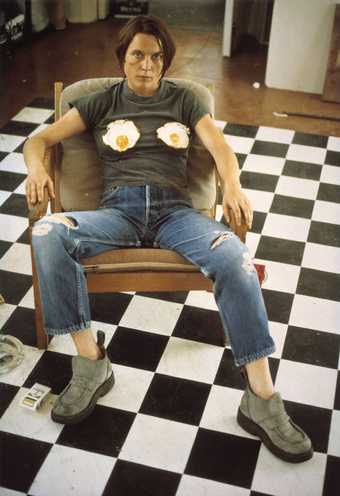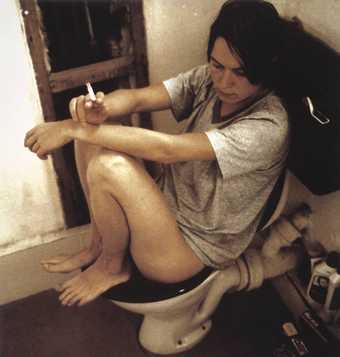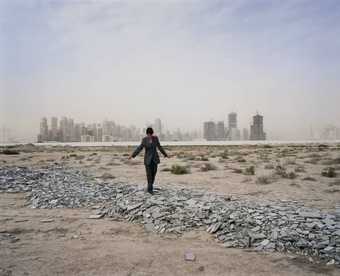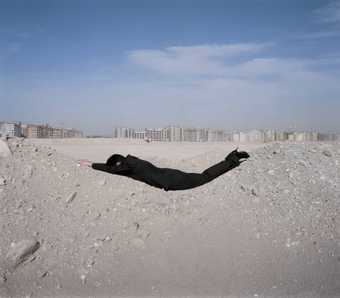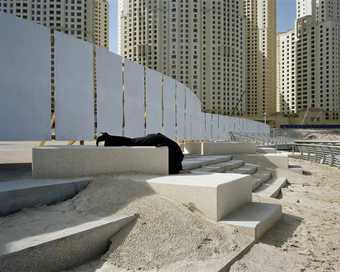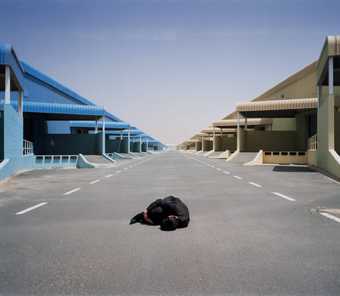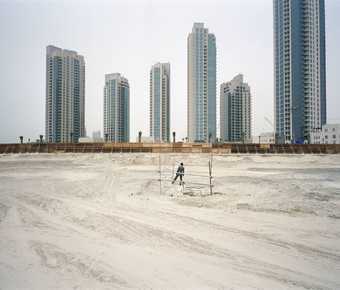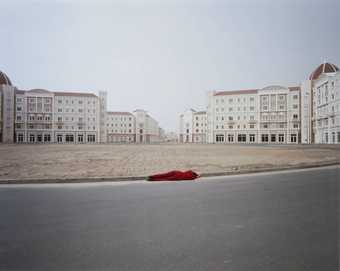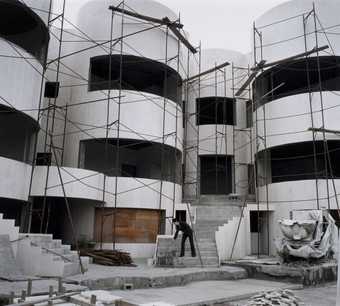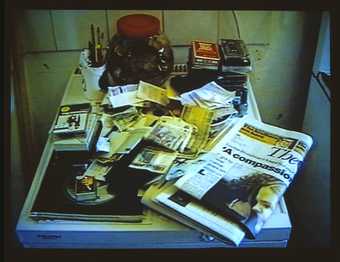
Not on display
- Artist
- Tracey Emin born 1963
- Medium
- Photograph, colour, on vinyl mounted onto aluminium
- Dimensions
- 1220 × 1830 mm
- Collection
- Tate
- Acquisition
- Presented by Tate Members 2004
- Reference
- T11888
Summary
This photograph results from a trip Emin made to the United States in 1994. She and her then boyfriend, the writer, curator and gallerist Carl Freedman, drove from San Francisco to New York stopping off along the way to give readings from her book, Exploration of the Soul 1994 (see Tate T11887). The photograph shows the artist sitting in an upholstered chair in Monument Valley, a spectacular location in the middle of the Arizona Desert, holding her book. Although it is open, it is not clear whether she is looking at the viewer or at the text in front of her. Emin gave her readings sitting in the chair, which she had inherited from her grandmother. She appliquéd significant words and sections of text onto it, including her and her twin brother’s names, the year of her grandmother’s birth (1901) and the year of her birth (1963) on either side of the words ‘another world’, referring to the passing of time. An exchange between the artist and her grandmother using the nicknames they had for each other: ‘Ok Puddin, Thanks Plum’, covers the bottom front of the chair and a saying of Emin’s grandmother’s, ‘There’s a lot of money in chairs’, is appliquéd in pink along the top and front of its back. Behind the chair back, the first page of Exploration of the Soul, handwritten onto fabric, is appliquéd together with other dictums such as, ‘It’s not what you inherit. It’s what you do with your inheritance.’ As she crossed the United States, the artist sewed the names of the places she visited – San Francisco, Los Angeles, San Diego, Las Vegas, Monument Valley, Detroit, Pittsburgh, New York - onto the front of the chair. Emin subsequently presented the chair as an artwork in its own right titled with her grandmother’s words, There’s A Lot of Money in Chairs 1994 (White Cube, London).
Emin’s work conflates her life with her art. Her practice includes performance and photographic records of performances. A series of nine images comprising the work Naked Photos – Life Model Goes Mad 1996 (private collection) document a painting performance Emin made in a room specially built in the gallery space of Galleri Andreas Brändström, Stockholm, in 1996. Another photographic series, Trying On Clothes From My Friends (She Took The Shirt Off His Back) 1997 (private collection), show the artist trying on her friends’ clothes. Emin has used large-scale photographs of herself to record and express moments of emotional significance in her life, frequently making reference to her career as an artist. The photographs have a staged quality, as though the artist is enacting a private ritual. For The Last Thing I Said to You was Don’t Leave Me Here I and II 2000 (see Tate P11921 and Saatchi Collection, London) the artist posed naked on the floor of a beach hut she had bought in Whitstable, Kent in 1992. Having used the beach hut as weekend retreat for several years, Emin converted it into an artwork by transporting it into the gallery for an exhibition at the Saatchi Gallery, London in 1999. The photographs refer to a possibly fictional moment in the past. Another large-scale image produced in the same year, I’ve Got it All (private collection), shows the artist, legs splayed on a red floor, clutching banknotes and coins to her crotch. Made at a time of public and financial success, the image connects the artist’s desire for money and success and her sexual desire (her role as consumer) with her use of her body and her emotional life to produce her art (the object of consumption). In Outside Myself (Monument Valley, reading ‘Exploration of the Soul’), the words ‘outside myself’ suggest that the artist has attained an ambiguous state of separation from herself. Like I’ve Got it All, the image brings together the multiple parts which make up the Emin artwork - the artist’s inner life as inspiration and subject of the work, the artist as performer and the work itself as a relic of the processes of creation and consumption.
The photograph was produced in an edition of three of which Tate’s copy is the first.
Further reading:
Tracey Emin, Exploration of the Soul, London 2003
Neal Brown, Matthew Collings, Sarah Kent, Tracey Emin, exhibition catalogue, South London Gallery 1997, reproduced p.30 in colour
The Turner Prize 1999, exhibition brochure, Tate Gallery, London 1999, [pp.4-5], reproduced [p.5] in colour
Elizabeth Manchester
November 2004
Does this text contain inaccurate information or language that you feel we should improve or change? We would like to hear from you.
Explore
- emotions, concepts and ideas(16,416)
-
- emotions and human qualities(5,345)
-
- memory(367)
- formal qualities(12,454)
-
- photographic(4,673)
- universal concepts(6,387)
-
- time(679)
- art and craft(2,383)
-
- appliqué(2)
- reading(400)
- chair(915)
- actions: postures and motions(9,111)
-
- sitting(3,347)
- woman(9,110)
- Emin, Tracey(7)
- self-portraits(888)
- countries and continents(17,390)
-
- USA, Arizona(22)
- arts and entertainment(7,210)
-
- artist, multi-media(393)
You might like
-
Tracey Emin The Last Thing I Said to You was Don’t Leave Me Here II
2000 -
Sarah Lucas Human Toilet Revisited
1998 -
Sarah Lucas Divine
1991 -
Sarah Lucas Self Portrait with Mug of Tea
1993 -
Sarah Lucas Self Portrait with Fried Eggs
1996 -
Sarah Lucas Human Toilet Revisited
1998 -
Carey Young Body Techniques (after A Line in Ireland, Richard Long, 1974)
2007 -
Carey Young Body Techniques (after Parallel Stress, Dennis Oppenheim,1970)
2007 -
Carey Young Body Techniques (after Lean In, Valie Export, 1976)
2007 -
Carey Young Body Techniques (after Sculpture II, Kirsten Justesen, 1969)
2007 -
Carey Young Body Techniques (after Encirclement, Valie Export, 1976)
2007 -
Carey Young Body Techniques (after Circles, Ulrich Ruckriem, 1971)
2007 -
Tracey Emin Tracey Emin C.V. Cunt Vernacular
1997

